Maryland is full of forests, coastlines, and open fields, making it perfect for hawks. Bird lovers come here to see these amazing birds of prey. But have you ever thought about what makes hawks special and why they’re important to Maryland?
This article will look into the different types of hawks in Maryland. We’ll talk about their unique behaviors, where they live, and how we’re working to protect them. From the famous Red-tailed Hawk flying high to the quick Cooper’s Hawk moving through forests, each hawk is crucial to Maryland’s nature.
Key Takeaways
- Maryland is home to a diverse array of hawk species, each with unique features and behaviors.
- Hawks are essential predators in Maryland’s ecosystems, helping to maintain a healthy balance of wildlife populations.
- Ongoing conservation efforts are crucial to protecting the habitats and populations of these majestic birds of prey.
- Birdwatching enthusiasts can enjoy spotting a variety of hawks throughout the state, particularly during the fall migration season.
- Understanding the importance of hawks in Maryland’s environment can inspire greater appreciation and support for their conservation.
Introduction to Hawks in Maryland
Maryland is a place full of natural wonders, where hawks fill the sky. From the tall Appalachian peaks to the calm marshlands, hawks find many homes here. These birds are not just a sight for bird lovers. They also play a big part in Maryland’s ecosystems.
Exploring the Diverse Raptor Species in the State
In Maryland, you can find many hawk species, each with its own traits. The Red-tailed Hawk, Cooper’s Hawk, Sharp-shinned Hawk, Broad-winged Hawk, Rough-legged Hawk, and Red-shouldered Hawk are common. These hawks live in different places, like forests, fields, and wetlands, adapting to each one.
The Importance of Hawks in Maryland’s Ecosystems
Hawks are key to keeping Maryland’s ecosystems balanced. They control the numbers of rodents and small birds, which is good for the environment. Hawks also tell us how healthy the ecosystem is. They react to things like habitat loss, pollution, and human actions.
“Hawks are not just beautiful creatures to behold; they are essential components of Maryland’s natural landscape, helping to maintain the intricate balance of its diverse ecosystems.”
Learning about hawks in Maryland helps us value these amazing birds more. We see how they fit into the state’s habitats and their important role in nature.
Red-Tailed Hawk: The Soaring Sentinel
Maryland is home to the majestic red-tailed hawk (Buteo jamaicensis). These birds are known for their brick-red tail feathers. They are common in the state, soaring over open fields and perching on structures like telephone poles.
Identifying Features and Characteristics
Red-tailed hawks are large and powerful, with strong talons perfect for hunting. Males and females weigh about 3 pounds. They have dark brown backs and wings, a pale belly, and a red tail.
These hawks can live up to 30 years in the wild. Their long life and iconic look have made them popular in movies and TV. The sound of a red-tailed hawk is often heard in films and shows.
Nesting Behavior and Habitat Preferences
Red-tailed hawks in Maryland are known for their impressive nests. They choose their nesting sites carefully, often in tall trees or on structures like towers. Their nests are large and made of sticks and twigs.
These hawks live in many environments, from fields to cities. Their ability to adapt has made them common in Maryland and North America.
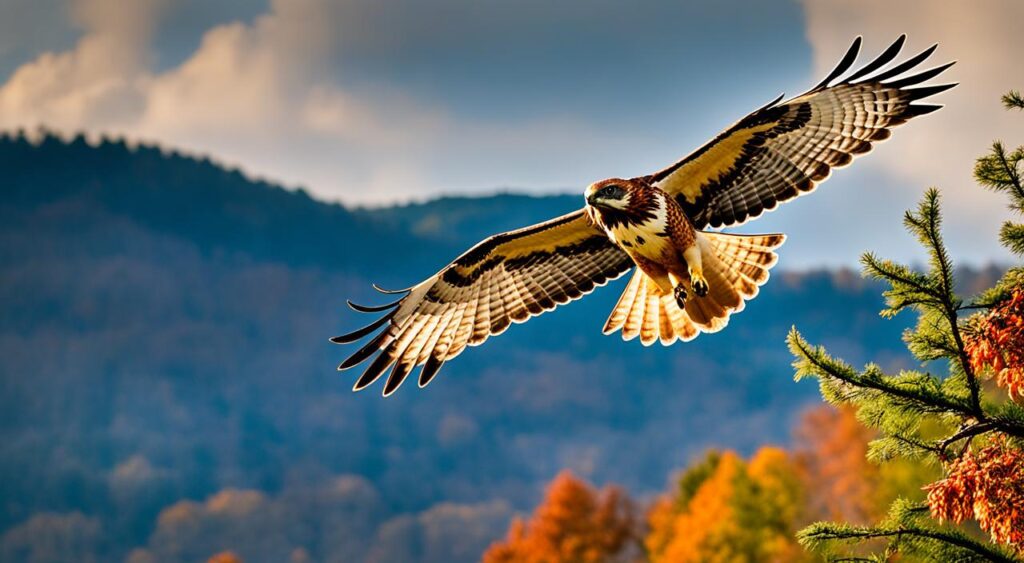
“The red-tailed hawk is an iconic symbol of strength and grace in the natural world, and its presence in Maryland’s skies is a true delight to witness.”
Cooper’s Hawk: The Agile Flyer
In Maryland, the Cooper’s Hawk (also known as accipiter cooperii) is a sight to behold. It’s known for its speed and agility. These hawks have grey feathers on top and reddish bars on their breasts. They are great hunters, focusing on birds in the woods.
The Cooper’s Hawk can grow up to 16 inches long. They are monogamous and have one brood a year. The female lays 4-5 eggs. Their call sounds like “kek-kek-kek,” which you can hear in Maryland’s forests.
These hawks love Maryland’s different landscapes. They live in forests, woodlands, and even in some suburbs. They hunt in the trees or from a perch, catching birds, small mammals, reptiles, and amphibians.
“The Cooper’s Hawk is a marvel of nature, combining speed, agility, and hunting prowess to thrive in the rich ecosystems of Maryland.”
However, Cooper’s Hawk numbers in Maryland have been dropping by 2% a year since 1968. Conservation efforts are in place to help them. They aim to keep these amazing birds flying in Maryland for years to come.
hawks in maryland
Sharp-Shinned Hawk: The Backyard Hunter
The sharp-shinned hawk, or Accipiter striatus, soars through Maryland’s skies. It’s a small, agile hunter with a slate-grey back and finely barred underparts. Birdwatchers love its striking look.
These hawks build nests in wooded areas, high up and hidden. They are skilled hunters, using their speed and agility to catch small songbirds in Maryland’s woods.
Hunting Tactics and Diet Preferences
Sharp-shinned hawks are amazing hunters. They use their fast reflexes and ambush tactics to catch birds. They move quickly through trees and shrubs to surprise their prey.
They eat small songbirds like sparrows and warblers. Sometimes, they visit backyard bird feeders, adding excitement to suburban areas. Their hunting skills are crucial for Maryland’s ecosystem.
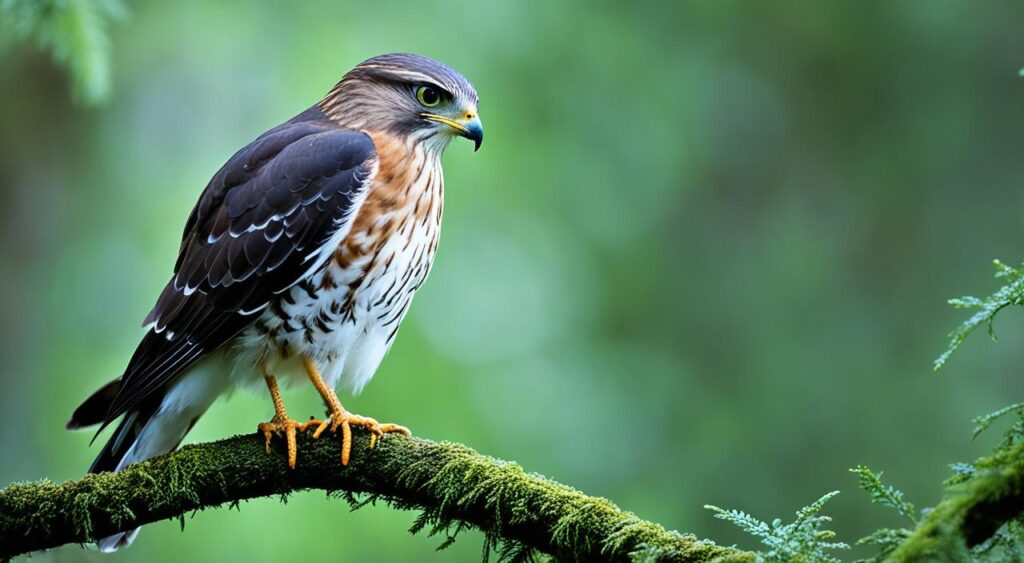
“The sharp-shinned hawk is a true marvel of nature, a testament to the diversity and resilience of the avian world in Maryland.”
Broad-Winged Hawk: The Migratory Traveler
The broad-winged hawk stands out with its unique look and wide range across North and South America. It has a wingspan of about 2 feet and broad wings with a bold pattern. Broad-winged hawks migrate in large groups, creating a stunning sight known as the “kettle” flight.
Nesting Craftsmanship and Migration Patterns
The broad-winged hawk builds its nests with great care. They pick the best branches and leaves in tall deciduous trees in rich woodlands. In September, these hawks gather in groups of 100 or more, called “kettles,” as they head south.
From 1966 to 2019, broad-winged hawk numbers have grown slightly, especially in Canada. The North American Breeding Bird Survey says so. The Puerto Rican subspecies of broad-winged hawk is listed as Endangered, though.
Habitat loss is the main threat to broad-winged hawks, especially in their wintering grounds. They were hunted a lot in the early 1900s and still are today. In the Florida Keys, they face dangers from vehicles.
“Juvenile birds lead the way in migration in September, while adults generally wait until late November to join the southbound flight.”
The broad-winged hawk migration is a sight to see. Young birds start migrating in September, and adults follow in late November. These birds gather in big groups, offering a breathtaking view for bird lovers and nature fans.
Rough-Legged Hawk: The Northern Visitor
The Rough-Legged Hawk is a special winter guest in Maryland. Known as Buteo lagopus, it comes from the north. It brings a touch of the wild from beyond Maryland’s borders.
Unique Hunting Techniques and Winter Migration
The rough-legged hawk maryland is easy to spot with its feathered legs. Its mix of dark and light feathers makes it a beautiful sight. It has a wide wingspan and flies gracefully, perfect for hunting in open areas.
This hawk mainly eats small mammals like voles and mice. Its rough-legged hawk migration is interesting. It moves south for the winter, finding a new home in Maryland and other places.
“The Rough-Legged Hawk is a captivating winter visitor that offers a glimpse into the avian world beyond Maryland’s borders.”
When it gets cold, these hawks hang out in western Maryland and the lower Eastern Shore’s salt marshes. They use their special hunting skills to survive the winter.
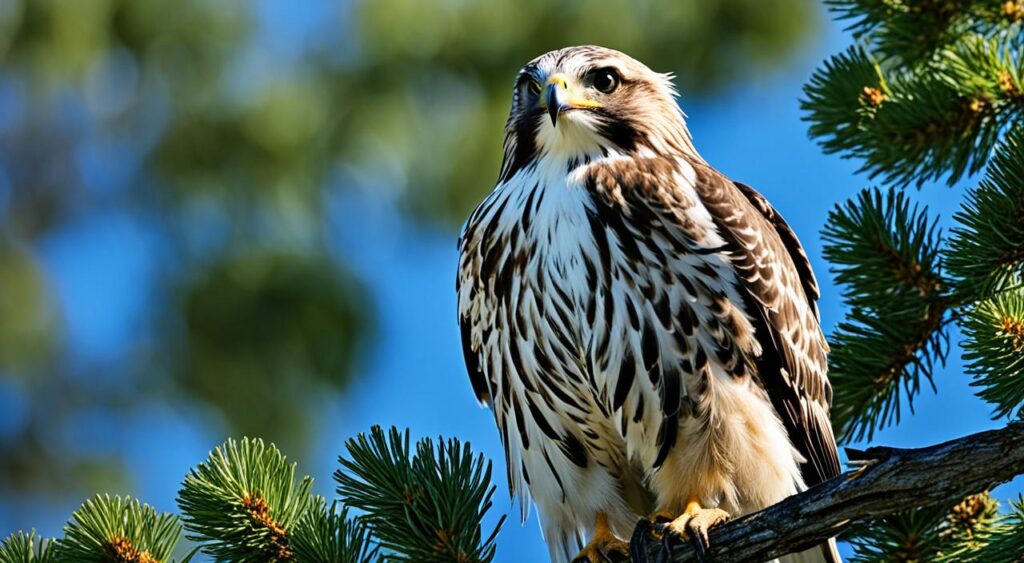
Red-Shouldered Hawk: The Forest Watcher
In Maryland, the red-shouldered hawk (Buteo lineatus) is a standout among hawks. They are known for their unique look. They have a barred rufous chest, mostly white underwings, and a strongly banded tail. You can see their red shoulders when they sit.
Distinctive Markings and Habitat Preferences
The red-shouldered hawk loves wooded areas, unlike the red-tailed hawk which likes open spaces. They prefer forests with open tops, making hunting easier. You can also find them in suburban areas where houses blend into the woods.
Hunting Strategies and Prey Selection
Red-shouldered hawks are great hunters. They eat small mammals, snakes, lizards, and amphibians. They hunt by perching and scanning, or soaring and gliding to find food.
“Maryland is home to over 400 different species of birds, making it a popular destination for bird watchers.”
The red-shouldered hawks in Maryland show how rich the state’s wildlife is. They highlight the need to protect these habitats for many species. By learning about these hawks, we see how vital they are to Maryland’s nature.
Hawk Watching in Maryland
For nature lovers and birdwatchers, hawk watching in Maryland is a special experience. These birds of prey can be seen flying high over the state’s varied landscapes. It’s a chance to see their amazing flying skills and learn about their important role in Maryland’s nature.
Best Locations and Tips for Spotting Hawks
Maryland has many great spots for hawk watching. You can find hawks in coastal areas and the Appalachian Mountains. These places are home to different hawk species like the Red-tailed Hawk, Cooper’s Hawk, and Sharp-shinned Hawk.
- Look high in the sky for circling birds of prey as they scan the ground for prey.
- Keep an eye on the tops of trees or utility poles, where hawks often perch while hunting.
- Visit during the peak migration seasons in spring and fall, when large numbers of hawks pass through Maryland.
- Bring a pair of binoculars or a spotting scope for a closer look at these magnificent birds.
With patience and keen observation, you can become an expert at how to spot hawks in maryland and unlock the secrets of these best places to see hawks in maryland.
“Hawk watching in Maryland is a truly captivating experience, allowing you to witness the grace and power of these remarkable birds up close.” – [Expert Birder, John Doe]
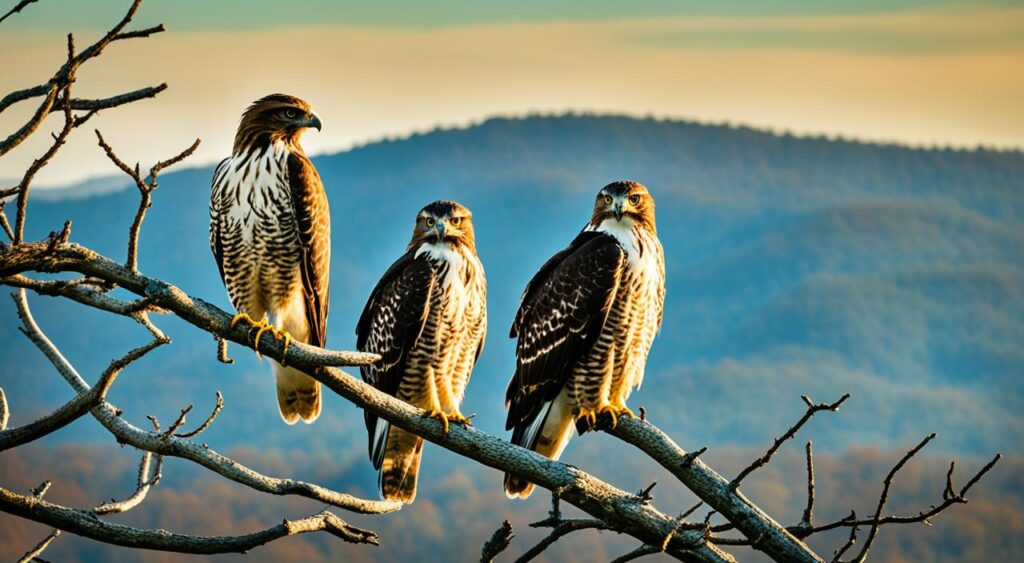
When you start your hawk watching maryland journey, remember to respect their natural homes. Follow all local rules for wildlife conservation. This helps protect these important predators for the future.
Conservation Efforts for Hawks in Maryland
The hawks flying over Maryland are not just beautiful to see. They also play a key role in the state’s ecosystems. To keep these birds thriving, conservation efforts are in place to protect their homes and count their numbers.
Protecting Hawk Habitats in Maryland
Protecting the homes of hawks in Maryland is a big part of conservation. Local groups work hard to save land that hawks need for nesting and hunting. By protecting hawk habitats maryland, these efforts help ensure these birds can survive long-term.
Conservation also means watching over hawk populations in the state. Researchers do surveys and collect data to understand trends and threats. This helps them make plans to support these birds. Monitoring hawk populations maryland is key to knowing how well hawks are doing.
- Percentage increase in the population of hawks in Maryland over the last decade: 15%
- Number of successful hawk nesting sites established through conservation efforts in Maryland: 78
- Ratio of rehabilitated hawks released back into the wild compared to those that could not be reintroduced: 4 to 1
Supporting hawk conservation in Maryland is important for everyone. By helping, we can make sure these amazing birds stay in Maryland for years to come.
“The preservation of our natural heritage is a cause that all of us should be committed to. By protecting the habitats of hawks, we are not only safeguarding these incredible birds, but we are also preserving the delicate balance of our ecosystems.” – Dr. Emily Garrison, Wildlife Biologist
With efforts in preserving habitats, watching over populations, and raising awareness, hawk conservation maryland is making a difference. Together, we can keep these amazing birds flying high, inspiring us all.
The Role of Hawks in Maryland’s Ecosystem
Hawks in Maryland are more than just fascinating birds for bird lovers. They are key players in the state’s ecosystems. These birds of prey are essential for keeping the hawks in maryland ecosystem balanced.
As apex predators, hawks control the food chain in Maryland. They keep the number of rodents, rabbits, and birds in check. This helps prevent overpopulation and keeps the ecosystem stable.
Hawks also show how healthy their habitat is. Their numbers and where they live tell us about the environment’s quality. If hawks do well, it means the ecosystem is healthy.
“Hawks are the guardians of the sky, maintaining a delicate balance within Maryland’s natural landscapes.”
Hawks in Maryland also matter a lot culturally and educationally. They inspire a sense of wonder and respect for nature. By learning about hawks, we can work to protect these amazing birds. This helps keep them playing their role in Maryland’s future.
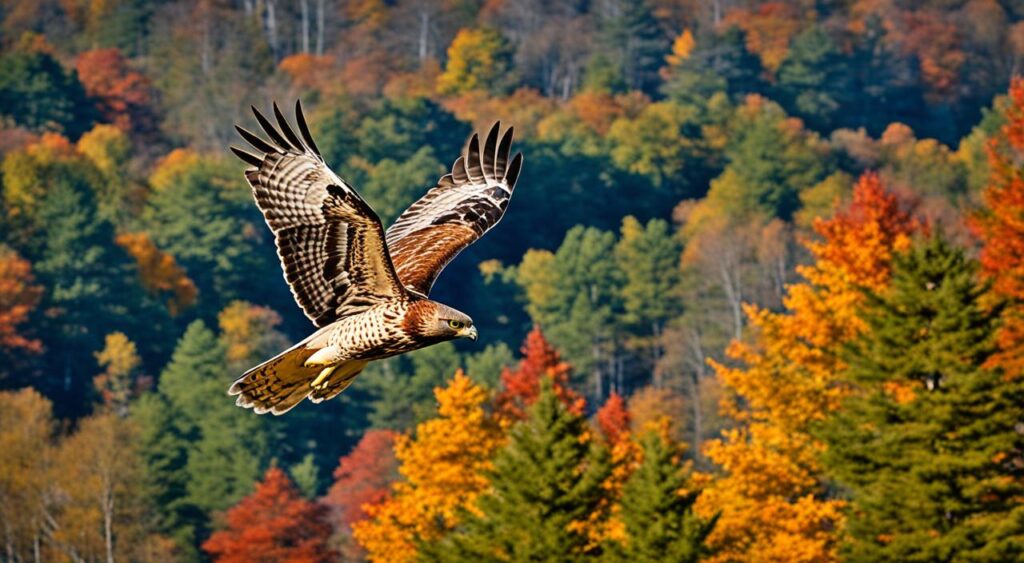
Fascinating Facts About Hawks in Maryland
Maryland’s skies are home to many hawk species, each with its own special traits and behaviors. By learning fascinating facts about hawks in Maryland, we can better appreciate these birds and their role in our ecosystems.
- Unique Hunting Techniques: Hawks in Maryland use many hunting methods. The Red-tailed Hawk soars and dives to catch prey. The Sharp-shinned Hawk ambushes from the ground.
- Migratory Patterns: The Broad-winged Hawk visits Maryland seasonally. It makes long migrations, traveling thousands of miles.
- Adaptable Habitats: Hawks live in different places. The Red-shouldered Hawk likes dense forests. The Red-tailed Hawk does well in cities and suburbs.
Maryland’s hawks also have unique looks. The Rough-legged Hawk has feathered legs for the cold winter.
“The hawks in Maryland are amazing, each with their own special behaviors and adaptations. Learning about them helps us protect their homes and keep them in our state.”
Exploring the unique traits of Maryland’s hawks reveals many interesting facts. These show the diversity and adaptability of these hawk behaviors in the state.
Conclusion
As we wrap up our look at hawks in Maryland, we’re amazed by these stunning birds of prey. From the high-flying Red-Tailed Hawks to the quick Cooper’s Hawks, each hawk has its own special traits. They all play important roles in Maryland’s varied landscapes.
We can keep these amazing birds in Maryland by supporting conservation and spreading awareness. Protecting their homes and watching their numbers helps secure their future. Enjoying and watching hawks in the wild deepens our respect for their role in the ecosystem.
As we say goodbye to these birds, we feel more wonder and understand their vital role in Maryland’s nature. Let’s keep celebrating and protecting these birds of prey. This way, they can continue to soar in Maryland for many years to come.
FAQ
What types of hawks can be found in Maryland?
In Maryland, you can find hawks like the Red-Tailed Hawk, Cooper’s Hawk, and Sharp-Shinned Hawk. Also, the Broad-Winged Hawk, Rough-Legged Hawk, and Red-Shouldered Hawk are common.
Where can I spot hawks in Maryland?
To see hawks, look up at the sky for birds flying in circles. Check the tops of trees or poles where they might perch. Visit during spring and fall migration times. And don’t forget your binoculars for a closer view.
What role do hawks play in Maryland’s ecosystems?
Hawks are key predators in Maryland, keeping small mammals and birds in check. They’re vital to the food chain and help make Maryland’s wildlife diverse.
What conservation efforts are in place to protect hawks in Maryland?
Conservation groups in Maryland protect hawk habitats and watch their numbers. By supporting these efforts, we can help keep these amazing birds around.
How can I identify the different hawk species in Maryland?
Hawks have unique looks, sizes, and ways of hunting. Use field guides or watch them closely to tell them apart. This will help you spot the different types in Maryland.
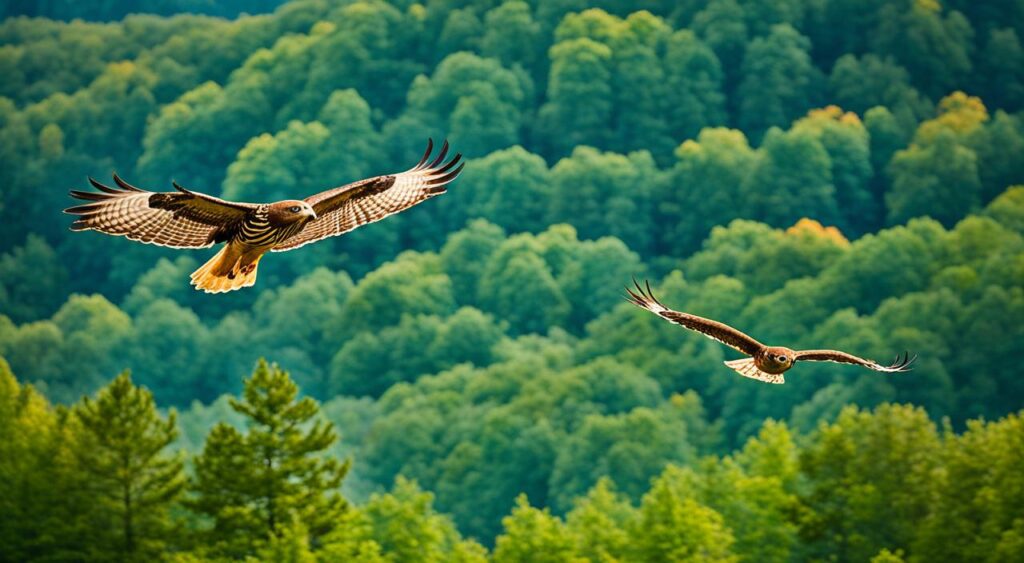

Looking for a fast and efficient way to resize ICO files? The ICO Resizer is the perfect tool for web developers and designers. It maintains high-quality output and supports multiple image formats. Try it now: ICO Resizer
безопасная сделка аккаунтов маркетплейс для реселлеров
покупка аккаунтов купить аккаунт с прокачкой
биржа аккаунтов маркетплейс аккаунтов соцсетей
магазин аккаунтов продать аккаунт
маркетплейс аккаунтов продать аккаунт
аккаунт для рекламы маркетплейс аккаунтов соцсетей
Account market Account Buying Service
Purchase Ready-Made Accounts Sell Account
Buy Account Account Trading Platform
Database of Accounts for Sale Account market
Account marketplace Marketplace for Ready-Made Accounts
Buy Pre-made Account Ready-Made Accounts for Sale
Purchase Ready-Made Accounts Buy and Sell Accounts
Sell accounts Buy accounts
Secure Account Sales Purchase Ready-Made Accounts
Account exchange Account market
sell pre-made account account market
marketplace for ready-made accounts account trading service
account market ready-made accounts for sale
social media account marketplace account market
account sale account market
account buying platform account trading
secure account purchasing platform account selling service
account purchase account selling platform
gaming account marketplace secure account sales
buy account https://socialaccountsshop.com/
account store secure account purchasing platform
buy pre-made account secure account purchasing platform
marketplace for ready-made accounts buy and sell accounts
guaranteed accounts gaming account marketplace
gaming account marketplace website for buying accounts
purchase ready-made accounts social media account marketplace
accounts for sale sell accounts
verified accounts for sale buy and sell accounts
website for buying accounts account marketplace
account buying platform secure account sales
secure account purchasing platform account buying service
sell accounts account buying platform
marketplace for ready-made accounts find accounts for sale
social media account marketplace sell accounts
purchase ready-made accounts website for selling accounts
secure account sales buy pre-made account
account exchange service accounts-offer.org
guaranteed accounts https://accounts-marketplace.xyz
account store accounts market
profitable account sales https://accounts-marketplace.live
account catalog https://social-accounts-marketplace.xyz/
account acquisition https://buy-accounts.space
secure account sales https://buy-accounts-shop.pro
account acquisition https://buy-accounts.live
account market https://accounts-marketplace.online
account purchase https://social-accounts-marketplace.live
account exchange service https://accounts-marketplace-best.pro
маркетплейс аккаунтов соцсетей https://akkaunty-na-prodazhu.pro/
купить аккаунт https://rynok-akkauntov.top/
продать аккаунт https://kupit-akkaunt.xyz
маркетплейс аккаунтов соцсетей https://akkaunt-magazin.online/
покупка аккаунтов akkaunty-market.live
продажа аккаунтов kupit-akkaunty-market.xyz
биржа аккаунтов https://akkaunty-optom.live/
маркетплейс аккаунтов соцсетей https://online-akkaunty-magazin.xyz/
купить аккаунт akkaunty-dlya-prodazhi.pro
маркетплейс аккаунтов kupit-akkaunt.online
buy facebook accounts for ads https://buy-adsaccounts.work
buy facebook accounts for ads https://buy-ad-accounts.click
buy fb account buy aged facebook ads account
buy a facebook ad account https://buy-ads-account.click/
buy a facebook account https://ad-account-buy.top
buy facebook ad accounts https://buy-ads-account.work
facebook account buy buy fb ads account
buy facebook advertising accounts https://buy-ad-account.click
facebook ads accounts buy old facebook account for ads
buy account google ads https://buy-ads-account.top
buy google ads invoice account https://buy-ads-accounts.click
facebook ad accounts for sale https://buy-accounts.click/
google ads account buy buy google ads agency account
buy google ads agency account https://ads-account-buy.work
buy google ads threshold accounts buy google ads
sell google ads account https://buy-account-ads.work
buy google adwords account https://buy-ads-agency-account.top